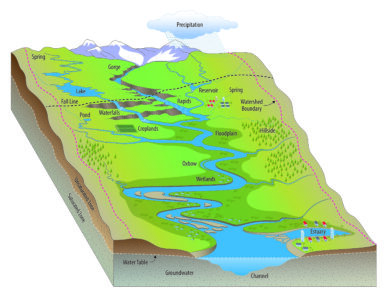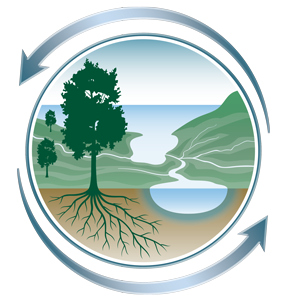Watershed Sciences
Watershed sciences research supported by the Environmental System Science (ESS) program seeks to advance a robust, predictive understanding of how watersheds function as integrated hydro-biogeochemical systems, as well as how these systems respond to disturbances such as changes in water recharge, availability, and quantity; contaminant release and transport; nutrient loading; land use; and vegetative cover.

River Corridor and Watershed Biogeochemistry. Installation of an aquifer tube to monitor the hydrologic exchange of river water and groundwater and associated biogeochemical processes in the Hanford Reach of the Columbia River. This tube and several others are concurrently monitored using geophysical methods for three-dimensional characterization of hydrologic exchange under varying river conditions, water sampling for biogeochemical analyses, and assessment of temperature and other water quality variables. [Courtesy PNNL]
Using a systems approach, ESS-supported researchers probe the multiscale structure and functioning of watersheds and capture this understanding in mechanistic models representing both the complexities of the terrestrial subsurface and ecohydrological interactions with surface waterbodies and vegetation. These models incorporate metabolic modeling of microbial processes; molecular-scale understanding of the stability, speciation, and interactions of inorganic elements with microbes, microbial communities, and plants; and diagnostic signatures of the system response at multiple spatial and temporal scales. State-of-the-science understanding codified in these models provides the basis for testing hypotheses, guiding experimental design, integrating scientific knowledge on multiple environmental systems into a common framework, and translating this information to support informed decision-making and policies.
Priority Research Objectives
ESS watershed science supports a network of testbed field sites to pursue five priority research objectives. These objectives include:
- Quantifying how biological behavior, abiotic-biotic interactions, and molecular transformations control the mobility of contaminants (e.g., uranium, technetium, and mercury), nutrients (e.g., nitrogen, phosphorus, and carbon), and critical biogeochemical elements (e.g., sulfur, iron, and manganese).
- Quantifying and predicting how hydrology drives fine-scale biogeochemical processes in surface-subsurface systems.
- Translating biogeochemical behavior across relevant molecular to watershed scales to accurately and tractably predict flows of water, nutrients, and contaminants.
- Identifying, quantifying, and predicting watershed responses to natural and anthropogenic perturbations and shifts to new states.
- Translating predictive understanding of watershed system function and evolution into near- and long-term environmental and energy strategies.
Data from research within these testbeds are incorporated into models that explain hydro-biogeochemical behavior at multiple spatial and temporal scales. In parallel with this approach, model and code developments are further advanced for these testbeds to guide additional measurement and experimentation, leading to an iterative cycle of modeling and experimentation.

Understanding Integrated Watershed Function. Watersheds serve as the fundamental hydrological units that connect terrestrial aquatic systems. ESS watershed science supports a network of testbeds across the contiguous United States that encompass watershed settings including headwaters, wetlands, ponded systems, and main-stem rivers.
Why Watershed Science Research is Important
Water resources critical for energy production are under pressure from growing water demand, contamination, drought, flooding, and saltwater intrusion. Sustainable management of these watershed systems and their coupling with the built environment rely on understanding the hydrological and biogeochemical processes controlling watershed system dynamics and water availability and quality. ESS watershed science is strategically aligned with the U.S. Department of Energy’s mission to provide next-generation science-based models of watershed systems that are needed to address U.S. energy and environmental challenges including contaminant cleanup, clean water availability, safe storage of energy and nuclear byproducts in the subsurface, nutrient availability for sustainable biofuel crops, and recovery of subsurface energy resources. Particular emphasis is placed on obtaining a mechanistic understanding of interactions and interfaces among water and land surface and subsurface processes in disturbed and managed U.S. ecosystems.
